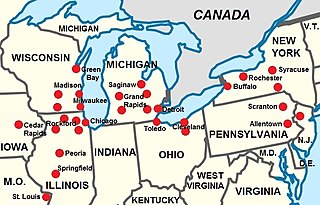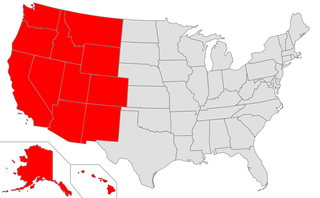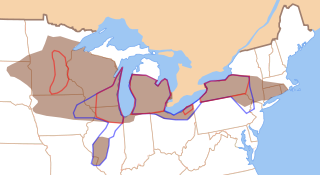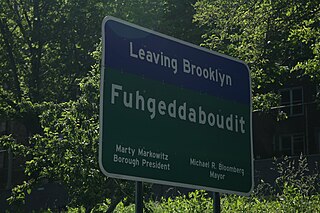Related Research Articles
American English, sometimes called United States English or U.S. English, is the set of varieties of the English language native to the United States. English is the most widely spoken language in the United States and in most circumstances is the de facto common language used in government, education and commerce. It is also the official language of most US states. Since the late 20th century, American English has become the most influential form of English worldwide.
General American English, known in linguistics simply as General American, is the umbrella accent of American English spoken by a majority of Americans, encompassing a continuum rather than a single unified accent. It is often perceived by Americans themselves as lacking any distinctly regional, ethnic, or socioeconomic characteristics, though Americans with high education, or from the North Midland, Western New England, and Western regions of the country are the most likely to be perceived as using General American speech. The precise definition and usefulness of the term continue to be debated, and the scholars who use it today admittedly do so as a convenient basis for comparison rather than for exactness. Other scholars prefer the term Standard American English.
Southern American English or Southern U.S. English is a regional dialect or collection of dialects of American English spoken throughout the Southern United States, though concentrated increasingly in more rural areas, and spoken primarily by White Southerners. In terms of accent, its most innovative forms include southern varieties of Appalachian English and certain varieties of Texan English. Popularly known in the United States as a Southern accent or simply Southern, Southern American English now comprises the largest American regional accent group by number of speakers. Formal, much more recent terms within American linguistics include Southern White Vernacular English and Rural White Southern English.
A Baltimore accent, also known as Baltimorese, commonly refers to an accent related to Philadelphia English that originates among blue-collar residents of Baltimore, Maryland, United States. It extends into the Baltimore metropolitan area and northeastern Maryland.
Eastern New England English, historically known as the Yankee dialect since at least the 19th century, is the traditional regional dialect of Maine, New Hampshire, and the eastern half of Massachusetts. Features of this variety once spanned an even larger dialect area of New England, for example, including the eastern halves of Vermont and Connecticut for those born as late as the early twentieth century. Studies vary as to whether the unique dialect of Rhode Island technically falls within the Eastern New England dialect region.
The English language as primarily spoken by Hispanic Americans on the East Coast of the United States demonstrates considerable influence from New York City English and African-American Vernacular English, with certain additional features borrowed from the Spanish language. Though not currently confirmed to be a single stabilized dialect, this variety has received some attention in the academic literature, being recently labelled New York Latino English, referring to its city of twentieth-century origin, or, more inclusively, East Coast Latino English. In the 1970s scholarship, the variety was more narrowly called (New York) Puerto Rican English or Nuyorican English. The variety originated with Puerto Ricans moving to New York City after World War I, though particularly in the subsequent generations born in the New York dialect region who were native speakers of both English and often Spanish. Today, it covers the English of many Hispanic and Latino Americans of diverse national heritages, not simply Puerto Ricans, in the New York metropolitan area and beyond along the northeastern coast of the United States.
In English, many vowel shifts affect only vowels followed by in rhotic dialects, or vowels that were historically followed by that has been elided in non-rhotic dialects. Most of them involve the merging of vowel distinctions and so fewer vowel phonemes occur before than in other positions of a word.
Philadelphia English or Delaware Valley English is a variety or dialect of American English native to Philadelphia and extending into Philadelphia's metropolitan area throughout the Delaware Valley, including southeastern Pennsylvania, counties of northern Delaware, the northern Eastern Shore of Maryland, and all of South Jersey. Other than Philadelphia and arguably Baltimore, the dialect is spoken in cities such as Wilmington, Atlantic City, Camden, Vineland, and Dover. Philadelphia English is one of the best-studied types of English, as Philadelphia's University of Pennsylvania is the home institution of pioneering sociolinguist William Labov. Philadelphia English shares certain features with New York City English and Midland American English, although it remains a distinct dialect of its own. Philadelphia and Baltimore accents together fall under what Labov describes as a single "Mid-Atlantic" regional dialect.
North American English regional phonology is the study of variations in the pronunciation of spoken North American English —what are commonly known simply as "regional accents". Though studies of regional dialects can be based on multiple characteristics, often including characteristics that are phonemic, phonetic, lexical (vocabulary-based), and syntactic (grammar-based), this article focuses only on the former two items. North American English includes American English, which has several highly developed and distinct regional varieties, along with the closely related Canadian English, which is more homogeneous geographically. American English and Canadian English have more in common with each other than with varieties of English outside North America.
The cot–caught merger, also known as the LOT–THOUGHT merger or low back merger, is a sound change present in some dialects of English where speakers do not distinguish the vowel phonemes in words like cot versus caught. Cot and caught is an example of a minimal pair that is lost as a result of this sound change. The phonemes involved in the cot–caught merger, the low back vowels, are typically represented in the International Phonetic Alphabet as and, respectively. The merger is typical of most Canadian and Scottish English dialects as well as some Irish and U.S. English dialects.
New England English is, collectively, the various distinct dialects and varieties of American English originating in the New England area. Most of eastern and central New England once spoke the "Yankee dialect", some of whose accent features still remain in Eastern New England today, such as "R-dropping". Accordingly, one linguistic division of New England is into Eastern versus Western New England English, as defined in the 1939 Linguistic Atlas of New England and the 2006 Atlas of North American English (ANAE). The ANAE further argues for a division between Northern versus Southern New England English, especially on the basis of the cot–caught merger and fronting. The ANAE also categorizes the strongest differentiated New England accents into four combinations of the above dichotomies, simply defined as follows:

Inland Northern (American) English, also known in American linguistics as the Inland North or Great Lakes dialect, is an American English dialect spoken primarily by White Americans in a geographic band reaching from the major urban areas of Upstate New York westward along the Erie Canal and through much of the U.S. Great Lakes region. The most distinctive Inland Northern accents are spoken in Chicago, Milwaukee, Detroit, Cleveland, Buffalo, Rochester, and Syracuse. The dialect can be heard as far west as eastern Iowa and even among certain demographics in the Twin Cities, Minnesota. Some of its features have also infiltrated a geographic corridor from Chicago southwest along historic Route 66 into St. Louis, Missouri; today, the corridor shows a mixture of both Inland North and Midland American accents. Linguists often characterize the western Great Lakes region's dialect separately as North-Central American English.

Western American English is a variety of American English that largely unites the entire Western United States as a single dialect region, including the states of California, Nevada, Arizona, Utah, New Mexico, Colorado, and Wyoming. It also generally encompasses Washington, Oregon, Idaho, and Montana, some of whose speakers are classified additionally under Pacific Northwest English.

Midland American English is a regional dialect or super-dialect of American English, geographically lying between the traditionally-defined Northern and Southern United States. The boundaries of Midland American English are not entirely clear, being revised and reduced by linguists due to definitional changes and several Midland sub-regions undergoing rapid and diverging pronunciation shifts since the early-middle 20th century onwards.

Northern American English or Northern U.S. English is a class of historically related American English dialects, spoken by predominantly white Americans, in much of the Great Lakes region and some of the Northeast region within the United States. The North as a super-dialect region is best documented by the 2006 Atlas of North American English (ANAE) in the greater metropolitan areas of Connecticut, Western Massachusetts, Western and Central New York, Northwestern New Jersey, Northeastern Pennsylvania, Northern Ohio, Northern Indiana, Northern Illinois, Northeastern Nebraska, and Eastern South Dakota, plus among certain demographics or areas within Michigan, Wisconsin, Minnesota, Vermont, and New York's Hudson Valley. The ANAE describes that the North, at its core, consists of the Inland Northern dialect and Southwestern New England dialect.

The sound system of New York City English is popularly known as a New York accent. The New York metropolitan accent is one of the most recognizable accents of the United States, largely due to its popular stereotypes and portrayal in radio, film, and television. Several other common names exist for the accent that associate it with more specific locations in the New York City area, such as "Bronx accent", "Brooklyn accent", "Queens accent", "Long Island accent", and "North Jersey accent"; however, no research has demonstrated significant linguistic differences between these locations.
The distinction between rhoticity and non-rhoticity is one of the most prominent ways in which varieties of the English language are classified. In rhotic accents, the sound of the historical English rhotic consonant,, is preserved in all pronunciation contexts. In non-rhotic accents, speakers no longer pronounce in postvocalic environments: when it is immediately after a vowel and not followed by another vowel. For example, in isolation, a rhotic English speaker pronounces the words hard and butter as /ˈhɑːrd/ and /ˈbʌtər/, but a non-rhotic speaker "drops" or "deletes" the sound and pronounces them as /ˈhɑːd/ and /ˈbʌtə/. When an r is at the end of a word but the next word begins with a vowel, as in the phrase "better apples," most non-rhotic speakers will preserve the in that position since it is followed by a vowel in this case.
The Atlas of North American English: Phonetics, Phonology and Sound Change is a 2006 book that overviews the pronunciation patterns (accents) in all the major dialect regions of the English language as spoken in urban areas of the United States and Canada. It is the result of a large-scale survey by linguists William Labov, Sharon Ash, and Charles Boberg. Speech data was collected, mainly during the 1990s, by means of telephone interviews with individuals in metropolitan areas in all regions of the U.S. and Canada. Using acoustic analysis of speech from these interviews, ANAE traces sound changes in progress in North American English, and defines boundaries between dialect regions based on the different sound changes taking place in them.
Western New England English refers to the varieties of New England English native to Vermont, Connecticut, and the western half of Massachusetts; New York State's Hudson Valley also aligns to this classification. Sound patterns historically associated with Western New England English include the features of rhoticity, the horse–hoarse merger, and the father–bother merger, none of which are features traditionally shared in neighboring Eastern New England English. The status of the cot–caught merger in Western New England is inconsistent, being complete in the north of this dialect region (Vermont), but incomplete or absent in the south, with a "cot–caught approximation" in the middle area.
In the sociolinguistics of the English language, raising or short-a raising is a phenomenon by which the "short a" vowel, the TRAP/BATH vowel, is pronounced with a raising of the tongue. In most American and many Canadian English accents, raising is specifically tensing: a combination of greater raising, fronting, lengthening, and gliding that occurs only in certain words or environments. The most common context for tensing throughout North American English, regardless of dialect, is when this vowel appears before a nasal consonant.
References
- ↑ Donohue, Brian (October 30, 2014). "Mischief night, goosey night? Subs, Hoagie? Nine maps showing how New Jersey talks". NJ Advance Media for NJ.com. Archived from the original on December 18, 2018.
- ↑ Jones, Taylor (2020). "Variation in African American English: The Great Migration and Regional Differentiation". University of Pennsylvania. Dissertations available from ProQuest: AAI27955096, p. 239.
- ↑ Part D Transmission and Diffusion [ bare URL PDF ]
- ↑ Labov, Ash & Boberg (2006 :47)
- ↑ Kurath, Hans (1949). A Word Geography of the Eastern United States. University of Michigan Press. ISBN 9780472085323.
- ↑ Labov, Ash & Boberg (2006 :47)
- ↑ Labov, Ash & Boberg (2006 :122)
- ↑ Labov, Ash & Boberg (2006 :181)
- ↑ Labov, Ash & Boberg (2006 :160)
- ↑ Labov, Ash & Boberg (2006 :233)